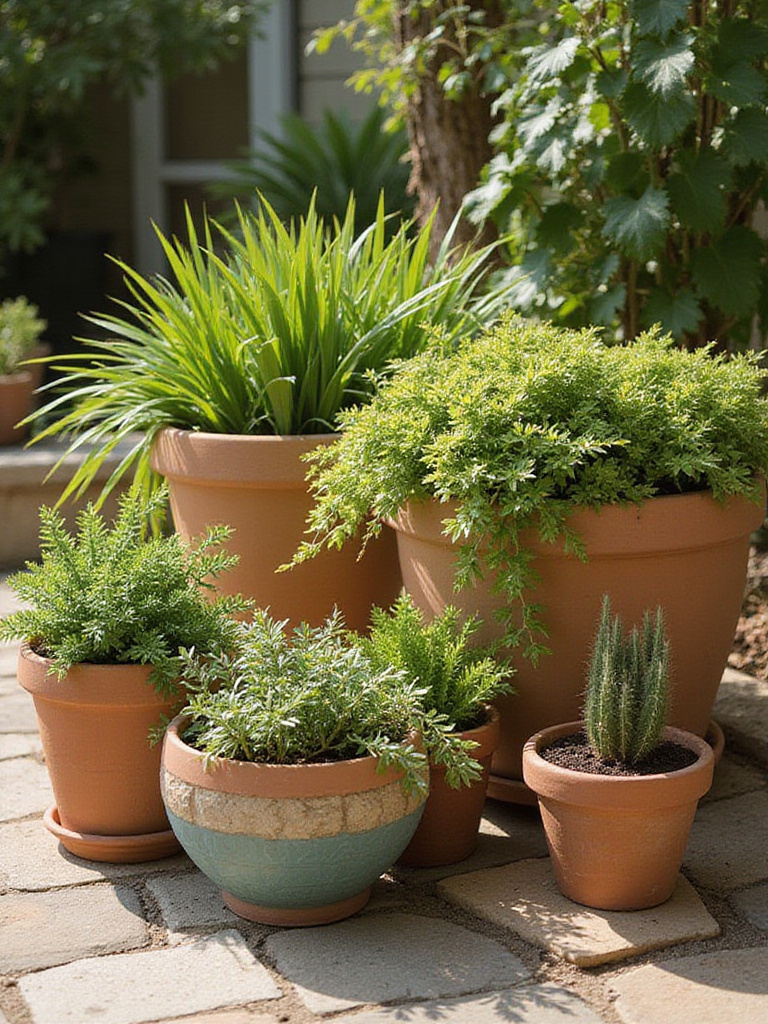Imagine stepping outside your back door and into a tranquil haven where fresh air mingles with vibrant colors and the day’s stresses simply melt away. Your patio has the potential to be so much more than just a concrete slab or wooden deck – it can become a true extension of your living space, a personal retreat designed for relaxation and connection with nature.
The secret ingredient? Plants! Patio plants bring life, color, and personality to your outdoor space. They soften harsh lines, purify the air, and create a welcoming atmosphere that invites you to linger longer. Whether you dream of a lush tropical escape, a fragrant floral paradise, or a chic minimalist green space, the right patio plants can make all the difference.
Ready to unlock your patio’s potential? Let’s explore 18 must-have patio plants that will guide you in creating the outdoor oasis you’ve always wanted.
1. Unleash Tropical Vibes with Bold Hibiscus
Dreaming of a tropical getaway without leaving home? Hibiscus plants are your answer! These flowering powerhouses bring an instant splash of exotic flair with their large, vibrant blooms that instantly transport you to warmer climates. Their relatively easy care routine in containers makes them ideal for patio gardening, with many varieties flowering repeatedly throughout spring and summer.

For container success, consider tropical hibiscus (Hibiscus rosa-sinensis) in regions with mild winters, or hardy hibiscus (Hibiscus moscheutos) for colder climates. Popular patio-friendly choices include ‘Fiesta’ with its variegated foliage, the regal ‘President’ with deep red flowers, and ‘Cranberry Crush’ known for rich pink blossoms. Ensure they receive at least 6 hours of direct sunlight daily, use well-draining soil, water regularly (especially during hot weather), and fertilize during the active blooming season.
Here’s where it gets interesting: pair hibiscus with other tropical-themed plants like canna lilies, elephant ears, and mandevilla for a complete tropical oasis effect. The visual impact of these combinations can transform even the most ordinary patio into something extraordinary.
2. Fragrant Jasmine: Evening Bliss for Your Patio
As the sun begins to set and the air cools, imagine your patio filled with the intoxicating scent of jasmine. This fragrant beauty creates a serene and relaxing evening atmosphere that elevates any outdoor space. The best part? There are several delightful options to choose from, each with its own unique charm.

Common Jasmine (Jasminum officinale) offers that classic sweet fragrance many adore, while Pink Jasmine (Jasminum polyanthum) provides a beautiful visual display with pink buds that open into white flowers. For a more subtle scent and different growth habit, Star Jasmine (Trachelospermum jasminoides) works beautifully on trellises or arbors. To maximize fragrance, place your jasmine in a sunny location near seating areas where you can easily enjoy its aroma as you relax. The scent is strongest in the evening, making it perfect for after-dinner patio gatherings.
The tricky part is ensuring proper care to maximize blooming. Jasmine needs at least 6 hours of direct sunlight, well-draining soil, consistent watering during blooming season, and regular fertilization. When pruning, do so after flowering to avoid cutting off next season’s buds – a common mistake that can leave you wondering where all the fragrance went.
3. Low-Maintenance Succulents: Chic Patio Greenery
For those seeking stylish greenery without the fuss, succulents are the perfect patio companions. These architectural wonders bring a modern, minimalist aesthetic while requiring minimal attention – ideal for busy gardeners or those new to plant care. Their drought tolerance, pest resistance, and adaptability to container gardening make them perfect for patios of all sizes.

When selecting succulent varieties, you’re spoiled for choice:
- Echeverias – Elegant rosette shapes in diverse color palettes
- Sedums – Versatile plants ranging from groundcovers to upright varieties
- Aloes – Architectural drama with striking, spiky leaves
- Haworthias – Compact “Zebra Plants” perfect for small containers
- Sempervivums – “Hens and Chicks” that produce numerous offsets
- Kalanchoes – Vibrant, long-lasting blooms for color pop
The breakthrough came when I realized that success with succulents hinges primarily on proper light exposure and restraint with watering. Most succulents thrive in bright, indirect sunlight to full sun, requiring at least 6 hours of direct sunlight daily. However, some varieties like Haworthias can tolerate partial shade. The most common mistake? Overwatering. Always let the soil dry completely between waterings, and remember that it’s easier to revive an underwatered succulent than an overwatered one.
4. Dramatic Caladiums: Color for Patio Shade
If your patio is blessed with shade, don’t think you have to sacrifice vibrant color! Caladiums are the stars of the shade garden, offering a spectacular display of foliage in a rainbow of hues without needing direct sunlight. Their large, heart-shaped leaves create dramatic visual impact even without flowers, adding unique texture and depth to shadier spots.

There’s a caladium variety for every color palette and patio style:
- ‘White Queen’ – Classic white leaves with striking green veins
- ‘Red Flash’ – Bold red leaves edged in green with pink speckles
- ‘Pink Symphony’ – Beautiful blend of various pink and green shades
- ‘Candidum Jr.’ – Compact white variety for smaller containers
- ‘Aaron’ – Pure white leaves with robust growth
What many people overlook is that caladiums need consistent moisture but hate waterlogged soil. Ensure your pots have good drainage holes to prevent tuber rot. Regular fertilization during the growing season will encourage lush foliage, and removing yellowing leaves promptly helps maintain their stunning appearance. Protect them from strong winds and temperatures below 60°F (15°C), which can damage their delicate leaves.
5. Vertical Garden Magic: Climbing Vines for Patio Walls
Maximize your patio space and add living art with climbing vines! These versatile plants transform bare walls into lush green tapestries, adding vertical interest and softening hardscapes. They effectively double your planting space by growing up instead of out – perfect for smaller patios where floor space is limited.

Choosing the right climbing vine depends primarily on your sunlight conditions:
For Sunny Patios: * Clematis – Breathtaking flowers in various colors * Passionflower – Exotic blooms and sometimes edible fruit * Mandevilla – Vibrant tropical feel with trumpet-shaped flowers
For Shady Patios: * Climbing Hydrangea – Elegant white flowers and lush foliage * English Ivy – Classic, low-maintenance option * Virginia Creeper – Stunning fall foliage in red and purple
The missing piece is often the right support structure. Twining vines like Clematis need thin supports to wrap around, while clinging vines such as English Ivy attach directly to surfaces (though this can damage paint or brick over time). Scrambling vines like climbing Roses need sturdy trellises or pergolas to lean on. Whatever you choose, ensure the support can bear the mature weight of the vine, especially after rain or snow.
6. Container Gardening 101: Choosing the Right Pots
The right container is just as important as the plant itself! Selecting appropriate pot size, material, and drainage is crucial for ensuring your patio plants flourish. Think of containers as both functional growing spaces and key design elements that contribute to your patio’s overall aesthetic.

When choosing pot size, consider the plant’s mature dimensions and root system. A pot that’s too small restricts root growth and requires frequent watering, while one that’s too large can lead to waterlogged soil and root rot. For materials, each has distinct advantages:
- Terracotta – Classic, porous, excellent airflow but dries quickly and can crack in freezing temperatures
- Plastic – Lightweight, affordable, retains moisture well but can fade and heat up in sun
- Resin/Fiberglass – Durable, lightweight, mimics other materials without the weight
- Metal – Modern look but heats up rapidly in direct sunlight
- Wood – Natural aesthetic, good insulation but can rot over time
Let me paint you a picture: drainage is absolutely critical. Without proper drainage holes, excess water accumulates, leading to root rot as roots suffocate and decay. Always place a layer of drainage material (gravel, broken pottery) at the bottom of pots to prevent clogging, and use well-draining potting mix specifically formulated for containers.
7. Sun-Loving Geraniums: Classic Patio Charm
For a burst of cheerful color and classic garden charm, you can’t go wrong with geraniums. These sun-worshipping beauties have been patio staples for generations, and for good reason. They thrive in full sun (at least 6 hours daily), offer vibrant colors from classic red to cheerful white and orange, and once established, show impressive drought tolerance.

To ensure your geraniums flourish and reward you with abundant blooms, plant them in well-draining potting mix and water thoroughly when the top inch of soil feels dry. Regular fertilization with a balanced, water-soluble fertilizer during blooming season encourages continuous flower production. The crucial maintenance task many gardeners overlook is deadheading – removing spent flowers promotes new blooms and prevents the plant from wasting energy on seed production.
“I’ve grown dozens of plants on my patios over the years, but geraniums remain my most reliable performers. Their vibrant colors and forgiving nature make them perfect for both beginners and experienced gardeners.”
The surprising part is that despite their common name, these popular patio plants aren’t true geraniums at all! They belong to the genus Pelargonium, while true geraniums (often called cranesbills) are in the genus Geranium. This naming confusion dates back to a historical misclassification, but the name “geranium” has stuck for these beloved patio classics.
8. Shade-Tolerant Impatiens: Color for Dimly Lit Patios
Don’t let a shady patio limit your floral displays! Impatiens are the champions of shade, bringing vibrant color to patios that receive little direct sunlight. Their remarkable ability to produce abundant blooms even in low-light conditions makes them ideal for brightening up areas where other flowering plants might struggle.

When selecting impatiens for your patio, you have several excellent types to choose from:
- Common impatiens (Impatiens walleriana) – Classic choice with prolific blooms in many colors
- New Guinea impatiens (Impatiens hawkeri) – More resistant to downy mildew with larger flowers
- SunPatiens – Hybrid variety tolerating both shade and some sun exposure
The heart of the matter is proper care, which is relatively straightforward. Impatiens require consistently moist soil (but not soggy), regular fertilizing every 2-3 weeks during growing season, and occasional deadheading to encourage more blooms. Good air circulation helps prevent fungal diseases, so avoid overcrowding your containers. One often-overlooked tip: impatiens can actually tell you when they need water – their leaves will start to droop slightly before damage occurs, giving you a clear signal it’s time to water.
9. Edible Patio Gardens: Fresh Herbs and Vegetables
Imagine stepping onto your patio and harvesting fresh herbs for tonight’s dinner or plucking ripe tomatoes for a lunchtime salad. Edible patio gardens combine beauty and practicality, bringing homegrown food right to your outdoor space. They engage all your senses – the sight of lush growth, the scent of herbs, the taste of fresh produce, and the satisfaction of growing your own food.

For beginners, these plants offer the best chance of success:
Easy Herbs: * Basil – Aromatic and perfect for Italian dishes * Mint – Vigorous grower great for drinks (best in its own container) * Chives – Mild onion flavor with pretty purple flowers * Oregano – Mediterranean staple that’s drought-tolerant * Thyme – Low-growing herb with tiny fragrant leaves
Container-Friendly Vegetables: * Cherry tomatoes – Prolific producers in sunny spots * Bell or chili peppers – Colorful and productive in pots * Lettuce and spinach – Quick-growing in partial shade * Radishes – Ready to harvest in just 3-4 weeks * Bush beans – Compact plants with good yields
The game-changer happened as I discovered that success depends largely on choosing the right containers and understanding sunlight needs. Most edible plants, especially fruiting vegetables like tomatoes and peppers, need at least 6 hours of direct sunlight daily. Leafy greens can tolerate partial shade (4-6 hours of sun). Always use containers with drainage holes and high-quality potting mix specifically formulated for containers – garden soil is too heavy and can become compacted.
10. Butterfly-Friendly Patio Plants for a Lively Space
Transform your patio into a buzzing haven for butterflies and other pollinators! Planting butterfly-friendly patio plants adds beauty while supporting a healthy ecosystem right outside your door. These winged visitors bring movement, color, and a sense of connection to the natural world that static decorations simply can’t match.

Many plants attract butterflies, but these are particularly effective:
- Milkweed – Essential host plant for Monarch butterflies
- Butterfly bush (Buddleja davidii) – Produces long, fragrant flower spikes
- Lavender – Fragrant purple flowers beloved by many pollinators
- Zinnias – Bright annuals offering accessible nectar
- Coneflowers (Echinacea) – Provide nectar and later seeds for birds
- Salvia – Long-lasting blooms attractive to butterflies and hummingbirds
- Pentas – Clusters of star-shaped flowers that butterflies love
Do you see how huge that is? Beyond just plants, you can enhance your patio’s appeal to butterflies by providing a shallow water dish with pebbles for drinking, avoiding pesticides that harm beneficial insects, ensuring sunny spots for basking, and grouping similar plants together to create concentrated nectar sources. The combination of these elements creates a butterfly paradise that transforms your patio into a living, moving garden.
11. Year-Round Greenery: Evergreen Shrubs for Structure
For patios that need definition, privacy, and year-round visual appeal, evergreen shrubs are invaluable. They provide structure and a consistent green backdrop throughout all seasons, unlike deciduous plants that lose their leaves in fall and winter. These steadfast plants create a sense of enclosure, shelter your patio from winds, define different areas, and offer wildlife habitat.

When selecting evergreen shrubs for your patio, consider these popular options:
- Boxwood (Buxus spp.) – Classic choice for formal gardens and containers
- Arborvitae (Thuja spp.) – Various sizes from screening to dwarf forms
- Dwarf Alberta Spruce (Picea glauca ‘Conica’) – Neat, conical form with slow growth
- Japanese Yew (Taxus cuspidata) – Shade-tolerant evergreen for hedges
- Rhododendrons/Azaleas – Flowering evergreens adding seasonal color
- Camellias – Exquisite winter or early spring blooms in warmer climates
Looking at this from another angle, success with evergreen shrubs in containers requires attention to a few key factors. Mature size is crucial – choose shrubs that will fit comfortably in your space at full size. Light requirements vary widely, so match the plant to your patio’s specific conditions. Most evergreens prefer well-draining soil, so amend your potting mix if needed. And always consider your hardiness zone to ensure the shrub can survive your local winters.
12. Patio Plant Watering Wisdom: Tips for Healthy Growth
Watering is the lifeblood of your patio plants. Mastering proper watering techniques is essential for their health and vibrant growth, yet it’s where many container gardeners struggle most. The challenge lies in finding that perfect balance – too little water causes drought stress, while too much leads to root rot.

Determining how often to water depends on several factors:
- Plant species and their natural water needs
- Pot size and material (smaller pots and terracotta dry faster)
- Soil type (well-draining mixes require more frequent watering)
- Weather conditions (hot, sunny, windy weather increases water needs)
- Plant growth stage (seedlings and flowering plants need more consistent moisture)
The key thing to understand is that checking soil moisture is more reliable than following a rigid schedule. Insert your finger about an inch into the soil – if it feels dry, it’s time to water. If it’s still moist, wait a day or two and check again. Signs of overwatering include yellowing leaves (particularly lower leaves), wilting despite wet soil, root rot, and water-soaked spots on leaves. Underwatering shows up as wilting, dry leaf edges, stunted growth, and soil pulling away from container sides.
What really matters here is water quality as well as quantity. Rainwater is ideal for patio plants – it’s naturally soft with low mineral content and free of chemicals like chlorine. If using tap water, let it sit for 24 hours to allow chlorine to evaporate. Avoid softened water with its high sodium content, and consider using filters for hard water to reduce mineral buildup. The goal is consistent, appropriate moisture that supports healthy growth without stressing your plants.
13. Protecting Your Patio Plants from Sun, Wind, and Pests
Patio plants, while beautiful, are vulnerable to environmental challenges. Protecting them from excessive sun, strong winds, and pests is crucial for their health and longevity. Since container plants can’t seek out better conditions on their own, it’s up to us to create the right environment for them.

For sun protection, consider using shade cloth that filters a percentage of sunlight without blocking it completely. Strategic umbrellas can provide temporary shade during the hottest part of the day. For plants that prefer partial shade, relocate them to spots that receive morning sun but afternoon shade. Light-colored pots reflect heat better than dark ones, and reflective mulch like light-colored pebbles can help regulate soil temperature.
“The best gardeners are those who learn to work with nature, not against it. Understanding your patio’s microclimate and adapting your approach accordingly is the secret to thriving plants.”
Just as we thought we understood the situation, wind protection presents another challenge. Strong winds can break stems, topple pots, and rapidly dry out foliage. Group plants closely to create mutual shelter, use heavier containers for stability, and consider installing windbreaks like lattice screens or solid fences. For delicate plants during high winds, temporary shelters made from burlap or garden fabric can provide crucial protection. Staking taller plants prevents them from bending or breaking in gusts.
14. Stylish Patio Plant Displays: Creative Container Arrangements
Patio plants aren’t just about individual specimens; it’s how you arrange them that creates visually stunning displays. Creative container arrangements can elevate your patio from simple to spectacular, turning a collection of plants into a cohesive garden that reflects your personal style.

The “thriller, filler, and spiller” principle offers a foolproof formula for container arrangements:
- Thriller – Tall, dramatic focal point plants (ornamental grasses, small shrubs)
- Filler – Medium-sized, bushy plants that add volume (petunias, geraniums, coleus)
- Spiller – Trailing plants that cascade over edges (ivy, creeping jenny, trailing petunias)
Beyond this principle, consider color harmony by choosing plants with complementary colors or creating monochromatic schemes. Ensure your selected plants have similar water and light requirements to thrive together. Experiment with container materials and shapes – terracotta for rustic charm, glazed ceramic for color, metal for modern appeal, wood for natural warmth. Varying heights with plant stands, pedestals, or tiered planters adds vertical interest and visual layers.
The patterns become clear when we examine how container groupings create more impact than isolated pots. Try clustering odd numbers of containers (3, 5, 7) for a naturally pleasing arrangement. Mix container sizes, shapes, and heights while maintaining some element of cohesion through color, material, or plant type. This approach creates a curated collection that feels intentional rather than haphazard.
15. Winterizing Patio Plants: Preparing for Cold Months
As summer fades and temperatures drop, preparing your patio plants for winter becomes crucial for their survival. Winterizing is especially important for container plants since their roots are more exposed to freezing temperatures than those in the ground. Without proper protection, cold temperatures, frost, and snow can cause significant damage to roots, foliage, and overall plant health.

Different plants require different winterizing approaches based on their hardiness:
- Tender tropicals (hibiscus, mandevilla, bougainvillea) – Bring indoors before first frost
- Semi-hardy plants (rosemary, lavender, some geraniums) – Provide insulation with burlap wraps, bubble wrap, or mulch
- Cold-hardy perennials – Move to sheltered locations like unheated garages or protected corners
The crucial decision point comes when preparing plants for indoor overwintering. Before bringing plants inside, inspect them thoroughly for pests and treat any infestations with insecticidal soap or neem oil. Prune back dead or damaged foliage to reduce size and remove potential disease sources. Gradually acclimate plants to indoor conditions by moving them to shadier outdoor spots for a week or two first. Reduce watering frequency once inside, as plants grow slower in winter with reduced light. Place them near sunny windows, ideally south-facing, or supplement with grow lights if natural light is limited.
16. Repotting Patio Plants: Refreshing Your Container Gardens
Just like us, patio plants sometimes need a fresh start. Repotting is an essential part of container gardening, revitalizing your plants and ensuring continued healthy growth. As plants grow, their roots eventually fill the available space, becoming “root-bound” – a condition where roots circle the inside of the pot, restricting further growth and hindering nutrient absorption.

Repotting provides several important benefits:
- Gives roots more space to expand
- Refreshes depleted soil with fresh nutrients
- Addresses drainage issues with new potting mix
- Allows inspection for root problems or pests
- Stimulates new growth and vigor
When we look beneath the surface, timing becomes critical for successful repotting. The best time for most patio plants is during their active growing season – typically spring or early summer. This allows plants to recover quickly and establish new roots while actively growing. Avoid repotting during dormancy (usually winter), which can stress plants and disrupt their natural rest cycle. Signs that a plant needs repotting include roots circling the pot or growing out of drainage holes, stunted growth despite proper care, soil drying out very quickly after watering, and plants becoming top-heavy or easily tipping over.
17. Solving Common Patio Plant Problems: Pests and Diseases
Even with the best care, patio plants can encounter pests and diseases. Knowing how to identify and treat these problems is key to keeping your green oasis thriving. Early detection and intervention can mean the difference between minor damage and losing your beloved plants.

Common pests that attack patio plants include:
- Aphids – Small, pear-shaped insects clustering on new growth
- Spider mites – Tiny arachnids creating fine webs and stippling on leaves
- Whiteflies – Small white flying insects that flutter up when disturbed
- Mealybugs – Cottony white pests in leaf axils and on stems
- Scale insects – Hard-shelled bumps attached to stems and leaves
- Slugs and snails – Nocturnal mollusks leaving slime trails and irregular holes
This might raise some questions about treatment options. For organic and natural pest control, consider neem oil (disrupts insect growth and feeding), insecticidal soap (suffocates soft-bodied insects), diatomaceous earth (dehydrates insects upon contact), beneficial insects (ladybugs, lacewings), handpicking larger pests, strong water sprays to dislodge aphids and mites, or homemade deterrent sprays using garlic, chili peppers, or onions.
The stumbling block is often disease identification. Watch for powdery mildew (white powdery coating), black spot (black spots with yellow halos), rust (orange/brown pustules), root rot (wilting despite moist soil, foul odor), and fungal leaf spots (various colored spots, often with concentric rings). Prevention is your best strategy – ensure good air circulation, avoid overhead watering, remove affected leaves promptly, and use disease-resistant varieties when possible.
18. Transform Your Patio into a Green Oasis: Plants for Your Style
Ultimately, your patio should reflect your personal style and create a space you truly love. Choosing plants that resonate with your aesthetic preferences is the final touch in creating your dream outdoor oasis. The right combination of plants can transform even the most ordinary patio into an extraordinary retreat.

Different patio styles call for different plant selections:
- Mediterranean – Olive trees, lavender, rosemary, citrus, geraniums, herbs
- Tropical – Banana plants, hibiscus, ferns, elephant ears, cannas, palms
- Modern – Succulents, ornamental grasses, bamboo, boxwood, phormiums
- Cottage Garden – Roses, hydrangeas, lavender, peonies, cosmos, foxgloves
The real story emerges when we examine how personal preferences shape your plant choices. Think about the colors that speak to you – vibrant and energizing or soft and calming? Consider textures you’re drawn to – lush and overflowing or clean and architectural? Include plants with special meaning, perhaps ones that remind you of a beloved family garden or a memorable vacation. Don’t be afraid to experiment and mix different plants, colors, and container styles to create a truly unique patio space that feels authentically yours.
Conclusion: Your Patio Plant Paradise Awaits
Creating your dream outdoor oasis with patio plants is both achievable and incredibly rewarding. From tropical hibiscus to fragrant jasmine, low-maintenance succulents to dramatic caladiums, we’ve explored a diverse array of plants to inspire your patio transformation. We’ve covered essential care techniques, creative display ideas, and solutions to common challenges.
Remember that your patio is an extension of your home – a space for relaxation, rejuvenation, and connection with nature. The plants you choose do more than just decorate; they create atmosphere, attract wildlife, clean the air, and respond to your care with beautiful growth. Your patio plants can transform an ordinary outdoor space into an extraordinary personal retreat.
Start small if you’re feeling overwhelmed, focusing on a few key plants that match your conditions and style. Be patient with the process and with yourself as you learn what works in your unique space. Most importantly, enjoy the journey of creating your patio plant paradise – the rewards of a beautiful, thriving outdoor oasis are well worth the effort.










